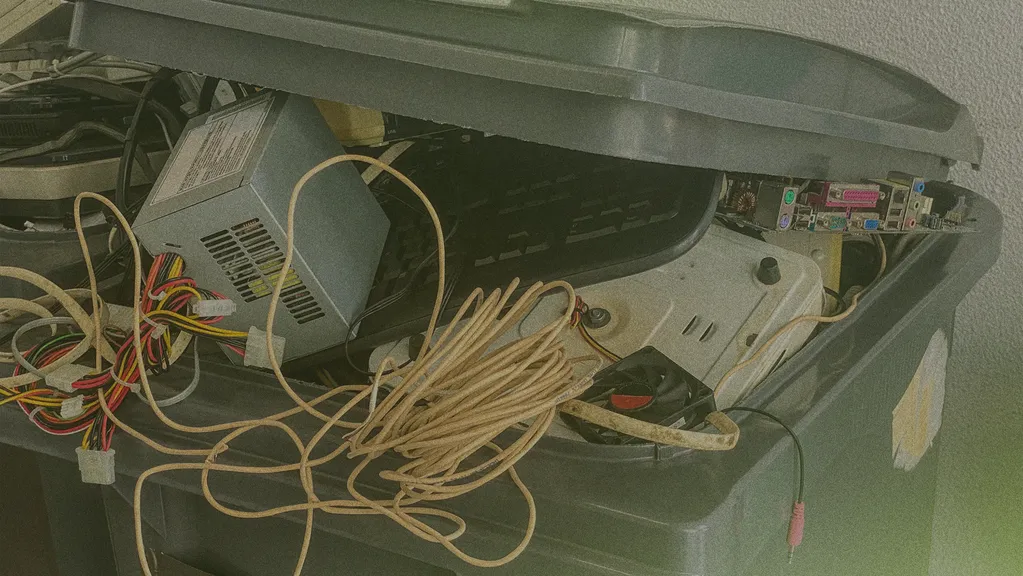What Is E-Waste?
E-waste refers to discarded electronic devices that are no longer functional, repairable, or safe to use. This includes broken smartphones, dead laptops, outdated TVs, and damaged appliances that have reached the end of their life.
According to the 2024 Global E‑waste Monitor report, the world generated approximately 62 million metric tons of e‑waste in 2022, and this number is projected to grow to 82 million metric tons by 2030.
E-waste doesn’t simply disappear. It gets dismantled, dumped, burned, or buried, and in the process, it releases chemicals that can poison soil, water, and air.
Guiyu, China, is a clear example of this. Once the world’s largest e-waste site, lead levels in river sediment there have been recorded at up to 190 times above safe limits, and nearly 80% of local children show signs of lead poisoning.
If we don’t manage e-waste responsibly, we’re trading convenience now for serious long-term damage.
What Happens When E-Waste Gets Tossed
Proper e waste disposal is important because, for one, inside almost every device are materials that become toxic once exposed to air, heat, or water.
Mercury can vaporize, cadmium can leak into groundwater, and lead can settle in soil. These chemicals move through ecosystems, contaminate drinking water, and accumulate in plants, animals, and eventually us..
But it’s not just the afterlife of electronics that causes damage, the front end of the process is just as destructive. Manufacturing these devices in the first place takes an enormous amount of energy, much of it powered by fossil fuels.
So when a phone or tablet gets discarded instead of reused, the energy that went into making it is wasted, and another round of emissions begins to replace it. Reuse cuts that cycle by keeping functional devices in circulation longer and slows the demand for constant manufacturing.
All this is to say, a broken screen doesn’t mean the whole device is useless, but tossing it in the trash makes sure it will be.
How to Dispose of E waste
Reuse E-Waste
Not all electronics that are no longer useful to you are automatically waste. Devices that still work, or could with minor repairs, can be reused by others.
Schools, community centers, libraries, senior centers, and nonprofits sometimes rely on donated electronics to meet their daily needs, so even older models of laptops, tablets, and smartphones can be refurbished, updated, and put back into use.
There are organizations specifically set up to manage this process. Groups like Human-I-T, PCs for People, and the National Cristina Foundation take donated electronics, wipe and repair them, then distribute them to low-income households, students, and people with disabilities. Some also offer tech support and low-cost internet to bridge the digital divide.
If you're upgrading your office or replacing home electronics, consider reaching out to one of these programs. Just make sure the item still works or is close to repairable.
Recycle E-Waste with Sourgum
If you’re dealing with a larger volume of e-waste, renting a roll-off dumpster makes the most sense. Our roll-off dumpsters are designed to simplify electronic waste disposal, whether you’re clearing out a home, office, or tech facility.
Curbside pickup and drop-off programs are useful for a few items, but they fall short when you have a large amount of e-waste to clear out or need to get rid of everything in one go.
Sourgum makes the process easy with roll-off dumpsters in a range of sizes, built to manage everything from home cleanouts to large-scale tech overhauls.
Once your container is on-site, load it at your pace. We coordinate with certified e-waste recyclers that know how to safely recover metals, plastics, and other components while keeping toxic materials out of the environment.
Every step of the process is handled with care. You won’t be left figuring out where your waste is going or whether it’s being recycled properly. We give you clear guidelines based on local requirements, and we route your dumpster to the right facility once it's picked up.
And because every bit helps, we plant one tree for every dumpster rented. Your cleanup supports long-term reforestation efforts through our trusted environmental partners.
Contact us and schedule a roll-off dumpster rental
Upcycle Your E-Waste
If you're handy or just curious, you can take old electronics apart and reuse the parts for something else – a process known as upcycling.
People have turned old monitors into fish tanks, TV sets into pet beds, and used parts like circuit boards and wires to build DIY speakers, lamps, or small robots. It’s a way to cut down on waste and maybe learn something along the way.
If you’re not sure where to start, there are tons of step-by-step tutorials online. Sites like Instructables have ideas for all skill levels. All you need is a bit of time, a screwdriver, and an old device you're ready to take apart.

